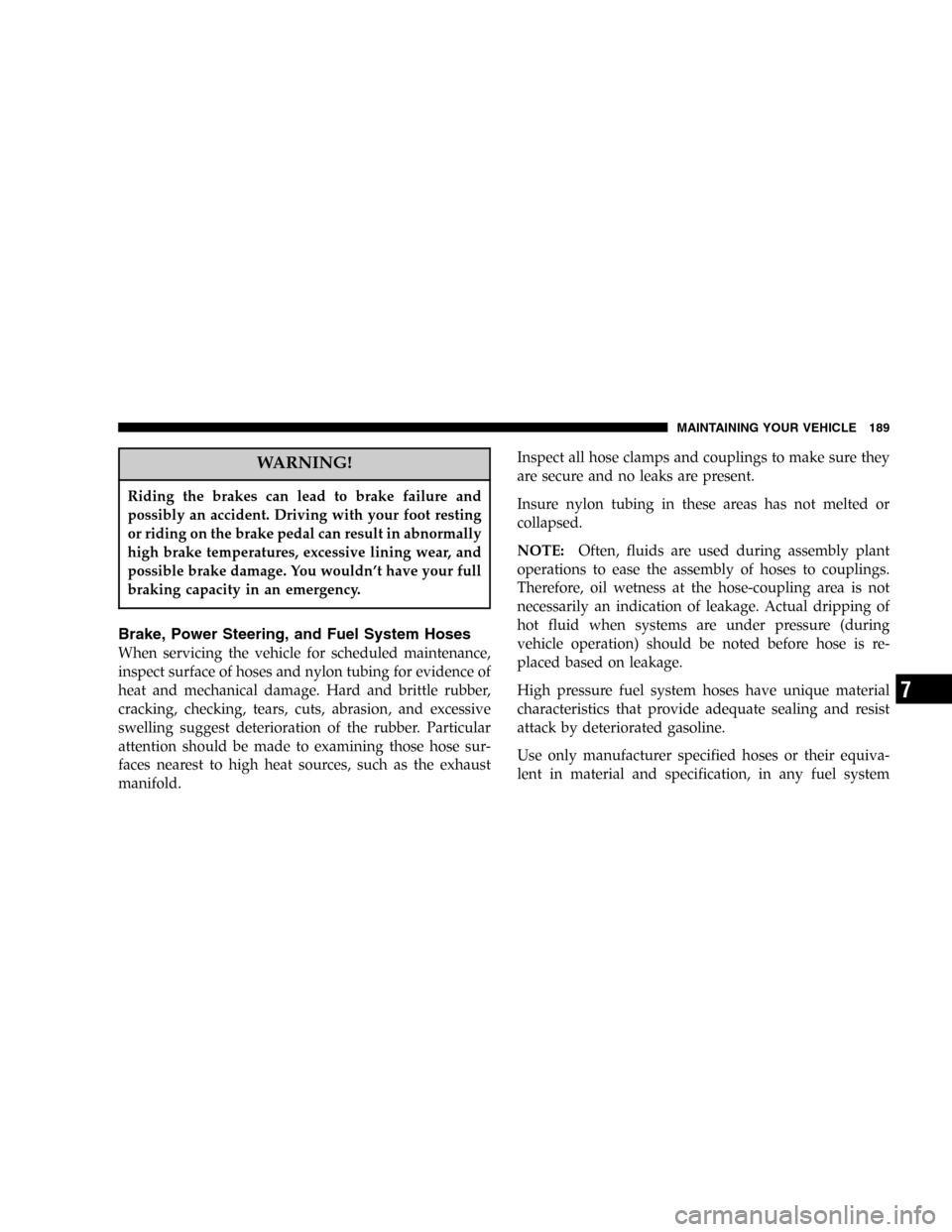Page 155 of 264
FREEING A STUCK VEHICLE
If your vehicle becomes stuck in mud, sand or snow, it
can often be moved by a rocking motion. Turn your
steering wheel right and left to clear the area around the
front wheels. Then shift back and forth between Reverse
and First gear. Usually the least accelerator pedal pres-
sure to maintain the rocking motion without spinning the
wheels is most effective.
CAUTION!
Racing the engine or spinning the wheels too fast
may lead to transmission/axle overheating and fail-
ure. It can also damage the tires. Do not spin the
wheels above 30 mph (48 km/h).
TOWING A DISABLED VEHICLE
Do not tow with sling type equipment. Only use flat bed
equipment. Always comply with applicable state or local
towing ordinances.
CAUTION!
Towing with equipment other than flat bed types
may damage your vehicle.
WHAT TO DO IN EMERGENCIES 155
6
Page 157 of 264
MAINTAINING YOUR VEHICLE
CONTENTS
�8.3L Engine Compartment................160
�Onboard Diagnostic System (OBD II).........161
�Emissions Inspection And Maintenance
Programs............................162
�Replacement Parts......................163
�Dealer Service.........................163
�Maintenance Procedures..................164
▫Engine Oil..........................164
▫Drive Belts—Check Condition And Tension . . 168▫Spark Plugs.........................168
▫Catalytic Converter....................168
▫Ignition Wiring System And Ignition Timing . . 170
▫Crankcase Emission Control System........171
▫Air Cleaner Filter.....................171
▫Maintenance-Free Battery................171
▫Battery Save Feature...................174
▫Air Conditioner......................176
▫Power Steering (Pump And Reservoir)......178
7
Page 158 of 264

▫Body Lubrication.....................179
▫Front And Rear Suspension Ball Joints......179
▫Steering Linkage......................180
▫Body Mechanism Lubrication.............180
▫Windshield Washers...................182
▫Exhaust System......................182
▫Cooling System.......................183
▫Hoses And Vacuum/Vapor Harnesses.......188
▫Brake System........................188
▫Brake, Power Steering, And Fuel System
Hoses.............................189
▫Brake And Clutch Fluid.................190
▫Master Cylinder......................191▫Hydraulic Clutch.....................192
▫Transmission........................193
▫Rear Axle...........................193
▫Wheel Bearings.......................194
▫Appearance Care.....................194
�Fuses—Power Distribution Center..........197
�Vehicle Storage........................202
�Replacement Bulbs......................204
▫Interior Light Bulbs....................204
▫Exterior Light Bulbs...................205
�Exterior Light Bulb Service................205
▫Headlight, Parking, Front Park, Turn Signal, Front
Sidemarker And Front Fog Light Removal....205
158 MAINTAINING YOUR VEHICLE
Page 178 of 264
Power Steering (Pump and Reservoir)
WARNING!
Fluid level should be checked with the engine off to
prevent injury from moving parts. Do not overfill.
Use only the manufacturer’s recommended fluid.
Refer to Recommended Fluids, Lubricants and
Genuine Parts for correct fluid type.
Check power steering fluid level at intervals as specified
in the maintenance schedules.
During scheduled maintenance, check the power steering
fluid level at the power steering fluid reservoir.The fluid should be checked HOT with the engine OFF.
Before removing the reservoir cap, wipe the outside of
the cap and reservoir so that no dirt can fall into the
reservoir.
Power Steering Fluid Reservoir
178 MAINTAINING YOUR VEHICLE
Page 179 of 264

All power steering pumps have a dipstick. Fluid level
should be maintained at the proper level indicated on the
dipstick. If necessary, add fluid to restore to the proper
indicated level. With a clean cloth, wipe any spilled fluid
from all surfaces. Only petroleum fluids specially formu-
lated for minimum effect on the rubber hoses should be
used. Use only the manufacturer’s recommended fluid.
Refer to Recommended Fluids, Lubricants and Genuine
Parts for the correct fluid type.
Body Lubrication
Locks and all body pivot points, including such items as
seat tracks, doors, liftgate and hood hinges, should be
lubricated periodically to assure quiet, easy operation
and to protect against rust and wear. Prior to the appli-
cation of any lubricant, the parts concerned should be
wiped clean to remove dust and grit; after lubricating
excess oil and grease should be removed. Particular
attention should also be given to hood latching compo-
nents to insure proper function. When performing otherunderhood services, the hood latch, release mechanism
and safety catch should be cleaned and lubricated.
The external lock cylinders should be lubricated twice a
year, preferably in the fall and spring. Apply a small
amount of a high quality lubricant such as Mopar�Lock
Cylinder Lubricant directly into the lock cylinder.
Front and Rear Suspension Ball Joints
Your vehicle has suspension ball joints that require
periodic servicing. These ball joints should be inspected
whenever servicing a vehicle for other reasons.
Damaged seals should be replaced to prevent leakage or
contamination of the grease. If there is any movement
within the ball joint, the knuckle or control arm must be
replaced. The ball joints are not serviceable by them-
selves.
MAINTAINING YOUR VEHICLE 179
7
Page 180 of 264

Relubrication
Ball joints are lubricated at the factory with a special
grease. They should be regreased at intervals as specified
in the maintenance schedules. When lubricating ball
joints, use only special long life chassis grease, such as
Multi-Mileage Lubricant, intended for this purpose.
Steering Linkage
There are two tie rod end ball joints that require periodic
inspection. The ball joint seals should be inspected when-
ever servicing the vehicle for other reasons. Damaged
seals should be replaced to prevent leakage or contami-
nation of the grease. The seals are not serviceable by
themselves, the entire outer tie rod end needs to be
replaced.
Lubrication
The tie rod ends are lubricated for life. No periodic
lubrication is required.
Body Mechanism Lubrication
Body and other operating mechanisms and linkages
should be inspected, cleaned, and lubricated, as required,
to maintain ease of operation and to provide protection
against rust and wear.
Before the application of any lubricant, the parts con-
cerned should be wiped clean to remove dust and grit;
after lubricating, excess oil or grease should be removed.
Hood Latch
When performing other underhood services, the hood
latch release mechanism and safety catch should be
inspected, cleaned, and lubricated.
It is important to maintain proper lubrication to insure
that the hood mechanisms work properly and safely.
Multi-Purpose Lubricant, NLGI Grade 2, should be ap-
plied sparingly to all pivot and sliding contact areas.
180 MAINTAINING YOUR VEHICLE
Page 189 of 264

WARNING!
Riding the brakes can lead to brake failure and
possibly an accident. Driving with your foot resting
or riding on the brake pedal can result in abnormally
high brake temperatures, excessive lining wear, and
possible brake damage. You wouldn’t have your full
braking capacity in an emergency.
Brake, Power Steering, and Fuel System Hoses
When servicing the vehicle for scheduled maintenance,
inspect surface of hoses and nylon tubing for evidence of
heat and mechanical damage. Hard and brittle rubber,
cracking, checking, tears, cuts, abrasion, and excessive
swelling suggest deterioration of the rubber. Particular
attention should be made to examining those hose sur-
faces nearest to high heat sources, such as the exhaust
manifold.Inspect all hose clamps and couplings to make sure they
are secure and no leaks are present.
Insure nylon tubing in these areas has not melted or
collapsed.
NOTE:Often, fluids are used during assembly plant
operations to ease the assembly of hoses to couplings.
Therefore, oil wetness at the hose-coupling area is not
necessarily an indication of leakage. Actual dripping of
hot fluid when systems are under pressure (during
vehicle operation) should be noted before hose is re-
placed based on leakage.
High pressure fuel system hoses have unique material
characteristics that provide adequate sealing and resist
attack by deteriorated gasoline.
Use only manufacturer specified hoses or their equiva-
lent in material and specification, in any fuel system
MAINTAINING YOUR VEHICLE 189
7
Page 214 of 264
Chassis
Component Fluid, Lubricant, or Genuine Part
Transmission Mopar Synthetic Manual Transmission Lubricant SAE 75W-85 (Castrol Syn-
torq LT 75W/85)
Rear Axle Mopar Synthetic Gear and Axle Lubricant SAE 75W-140, with Limited Slip
Additive Friction Modifier
Brake Master Cylinder Mopar�Brake & Clutch Fluid DOT 4 Motor Vehicle
Power Steering Reservoir ATF+4
214 MAINTAINING YOUR VEHICLE